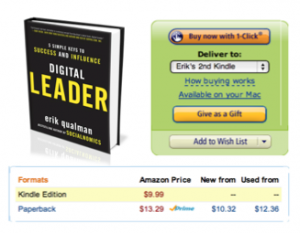Erik Qualman's Blog, page 645
December 13, 2012
TV Goes Social: The Rise of the Second Screen

These days, the simple act of watching a programme or a movie on TV isn’t enough, and our attention wanders to our smartphones and tablets as we watch. We use our mobile devices to look up related info about what we’re watching, to take part in real-time discussions about a TV episode, or to rant about that awful direct-to-TV sequel of your favourite movie. The second screen has arrived and it looks as though it’s here to stay.
Brought to you by Confused.com – Get yourself the perfect smartphone deal
[image error]
December 11, 2012
Why SEO Is Important for Each of Your Franchises

 Many very successful companies branch out by creating franchises, and rightfully so. Creating a franchise is a great way to help grow your company to different locations and get more people involved in production. What all companies need to realize, however, is that each individual franchise has its own particular needs. Although you may have one national advertising budget, the money needs to be dispersed amongst each franchise as not necessarily the company as a whole. One of the biggest areas that companies often forget is SEO and the importance of SEO for each franchise.
Many very successful companies branch out by creating franchises, and rightfully so. Creating a franchise is a great way to help grow your company to different locations and get more people involved in production. What all companies need to realize, however, is that each individual franchise has its own particular needs. Although you may have one national advertising budget, the money needs to be dispersed amongst each franchise as not necessarily the company as a whole. One of the biggest areas that companies often forget is SEO and the importance of SEO for each franchise.
Why SEO Services Are Needed for All of Your Franchises
If you own many different franchises, it can be tough to know where you should spend your budget. Advertising is one of the trickiest aspects to franchise ownership because you’re working with one company and multiple different stores. It might make sense to use all of your resources to promote the company as a whole, but SEO is one area where each franchise needs its own resources. The reason: local search.
For those who are unfamiliar, local search is one of the ways that Google makes sure all search results are tailored and relevant to users. Therefore, each one of your individual franchises should have its own SEO campaign so that the website is tailored specifically to those local users; thus helping your website rank in the local results—easier to rank well for—as opposed to other Google results—more competition.
How Local Search Optimization SEO Will Help Your Franchises
If each of your franchises has its own budget for SEO, there are a few things that can happen to help you rank well:
Google+. The connections you make on Google+ are not incredibly important when it comes to local search. If your franchise can connect with local customers through Google+, you’ll have a better chance of ranking on their search engine results pages (SERPs).
Targeted Content and Keywords. Google always wants the most relevant content to show up at the top of a user’s SERP, and having an SEO budget for each of your franchises can really make this happen. You can do research based on the area and the competition in that area to target specific, tailored keywords. This will help you rank well for all of your franchises because you have the write keywords and data, and thus it will help you bring in customers from all over.
Specific Data. Having data for each individual franchise will only help you improve. If you have one huge number for all of your different franchises you’re not getting the big picture. For example, you might make a layout change that worked well for one of your franchises for whatever reason (competition, audience, etc.). As a side note, it’s always better to work with a smaller pool of data than make assumptions about your large numbers.
Knowing that you need SEO for franchises is crucial. It helps to hire an SEO agency or in-house expert to work on each of these campaigns. You will most likely want to hire more than one person or agency to help get you started, but they should work together to help make sure that the message of your company is remaining consistent throughout. Other than that, it’s OK to have a different data for each franchise (in fact, you should!).
Do you spread your national advertising budget out across all of your different franchises? How do you make this work for you? Let us know your thoughts in the comments below.
Photo Credit: reterepins.com
[image error]
Heat Up Your Energy Savings By Turning to Social Media

 What is your New Year’s resolution for 2013? Could it be putting more energy into saving money on just that, your energy bills?
What is your New Year’s resolution for 2013? Could it be putting more energy into saving money on just that, your energy bills?
Whether you run a small business or are just your everyday consumer, saving money should always be high up on your list of importance. Without a focus on your expenses, you could be literally throwing money out the window.
So, how does the ordinary person who is watching their pennies find ways to save on their energy bills?
More individuals are learning that social media can be a good tool to turn to, especially when it comes to becoming more educated on how to lower office or home heating and cooling bills.
According to research from J.D. Power and Associates, residential customers of electric utilities claim to be much more satisfied when they view information on their utility provider’s social media sites.
The 2012 study noted that the overall customer satisfaction index was 744 (on a 1,000-point scale) among those customers remembering information on their utility’s social media site, but just 625 among all other customers.
As the usage of social media expands in many different industries, consumers and small business owners need to turn to energy company pages on Facebook, Twitter, Google+ and more, seeing where they are missing out on savings.
For some examples:
* Google your energy provider – Some energy providers have enacted what are essentially known as social media digital care teams, individuals who provide consumers with online information to help them save energy and money at the same time. The teams offer links to educational tools, including how to remain safe around electricity, plus provide needed updates when power goes down. The best way to go about locating such sites is placing an energy provider’s name on Google or a term like Cincinnati heating, then search for its home site and social media pages;
* U.S. Dept. of Energy – The Energy Department earlier this year unveiled the Utility Data Access Map tool, an interactive web platform that permits electric utilities nationwide to show consumers, in an easy manner, the data they can visit on their electricity usage. According to the DOE, it has received responses from hundreds and hundreds of participating utilities;
* The Alliance to Save Energy - This non-profit coalition of business, government, environmental and consumer leaders, backs energy-efficient policies to lessen the expenses to consumers, society and the environment, offering a wealth of energy-conservation data for consumers. The coalition offers its information on social media sites like Facebook, Twitter, Flickr and YouTube;
* The American Council for an Energy-Efficient Economy (ACEEE) – The council provides energy-efficient tips for those thinking about remodeling their home or those just searching for some inexpensive ways to save on energy. Among the educational pieces are things like how to shop for energy-efficient appliances and how to select the right contractor. They are also active on social media sites, including Facebook and Twitter;
* Speak out – Lastly, don’t be afraid to speak out with customer questions and complaints on provider social media pages. Just one comment can not only resonate with other consumers, but it can oftentimes draw a quicker response from the energy provider, those who fear getting bad publicity from such online matters. While some may choose to ignore questions and comments, many others either have or are starting to get the message that social media does matter.
At the end of the day, social media revolves around engagement in a two-way conversation, one that more and more energy providers seem willing to have.
Photo credit: ripower.org
[image error]
How to Gift a Kindle Book to Someone this Holiday

For all you last minute shoppers like me, it’s never too late this holiday season – ebooks have same day delivery.
Purchasing Kindle Books as Gifts
Kindle books available for purchase can be given as a gift to anyone with an e-mail address. You do not need a Kindle device to send or receive Kindle ebook gifts, and the recipient can read their gift on a registered Kindle device or any free Kindle reading application.
How to Gift a Kindle Book
Click the Give a Gift button located under the Buy button for that kindle book (see image)
It’s important that you need to be on the Kindle page version for the book (see image)
Enter the e-mail address for your gift recipient*
Enter a delivery date**
Enter an optional gift message
Click the Place your order button to finish your gift purchase using your Kindle 1-Click payment method.
*Use the personal e-mail address for your gift recipient, not their kindle.com e-mail address.
**Gift Notification - Your gift recipient will be notified of their gift at the e-mail address you provide. The notification will be sent at the time the gift order is placed or you can schedule the delivery of your gift. When you choose a delivery date, the e-mail notification will be sent to your gift recipient between 12:00 a.m. and 3 a.m. Pacific Time on the delivery date.
You can also gift Kindle books through your recipient’s Amazon Wishlist. Note that free books, books on pre-order, and other subscription content cannot be gifted at this time.
Paying for Gifted Kindle eBooks
Purchases of Kindle books as gifts uses your default 1-Click payment method. If you do not have a 1-Click payment method set up, you will be prompted to do so during the purchase process.
Viewing and Resending Gift Orders
You can see the Kindle book gifts you’ve purchased in Your Account. From the order summary, you can redeliver the gift if needed.
Click here to gift Digital Leader to someone
Click here to gift Socialnomics to someone
[image error]
How technical innovations and social media change consumer insights?

In our fast moving world it’s essential for modern companies to understand consumer’s wishes and needs.
The substantial technical progress influences the way how consumer insights are collected and analysed. That raised the question how companies could use technical innovations and social media to explore obvious and hidden consumer needs.
To a first impression on how our society changes in terms of their consuming behaviour and general lifestyle we have to look at the Internet usage.
In the first quarter of 2011 73% of households in the European Union were online. In 2006 it was only the half of all households.
Let’s have a view on the other side of the ocean: Currently 6% of all retail sales in the U.S. come from online sales and it’s predicted to grow up to 8% in 2014.
Considering this, the reasons why consumer insights have to change can be merged into three areas:
The way how data are collected changes.
The way how the resulting communication with the consumers is done changes.
The speed in which innovations are made and consumers react on them changes.
How are data collected?
Today Facebook, Twitter or other services are used to share information on how a new Hollywood Blockbuster or App is received by the consumer.
Google had become the synonym for searching on the Internet, no matter what kind of contents. But Google is not a commercial search engine, they’re an advertising company using “crawlers” to gather consumer preferences. With the Google tools companies can analyse how long consumers stay on a website and which products are checked out and how long.
These ways of data collection are more reliable then the classical tools of consumer insights, no cheating on consumer interviews of surveys.
How are consumer communications done?
Companies are already using the Internet and social media to communicate with their consumers. 71% on the companies are using Facebook, 59% of the companies are using Twitter.
But there is also a risk for the companies. Consumers are starting to break up with brand “follows” or “likes” on Facebook, because their walls are becoming too crowded by advertisements or too many posts of the company/brand annoy them.
Many users only follow or like companies to receive discounts (61%) not because they want to be supportive or they’re interested in the company/brand.
Companies often focus on social media advertisements and posts because they can be used faster and cheaper then classical methods. Reactions on trends can be monitored faster, too.
The speed how innovations are made
Especially in new technology business many new innovations are made daily. New Start Ups on web services are founded in a high frequency. That affects how these companies
communicate in this dynamical environment. Business ideas, product innovations or feedback is shared via Twitter or Facebook. Cheap feedback can be generated to identify obvious or hidden consumer needs, which increases the company’s flexibility.
Conclusion
The use of consumer insights can generate an added value for companies. It can influence the complete consumer communication and marketing mix.
The new technologies and social networking can help to build consumer relationships and answer market questions. But also the risks of these tools have to be considered to ensure a balanced way of communication between new and classical methods.
References and further reading
EuroStat
http://epp.eurostat.ec.europa.eu/cach...- EN.PDF
heise.de
Naone, E. (2010): Web 2.0 als Stimmungsbarometer [ONLINE] in heise.de http://www.heise.de/tr/artikel/Web-2-... [30.12.2011]
Harvard Business Review
http://blogs.hbr.org/cs/2011/09/socia... Reppesgaard, L. (2008): Das Google Imperium, 1st edition, Hamburg: Murmann
Kotler, P. (2003): Marketing Insights from A – Z – 80 concepts every manager needs to know, 1st edition, New Jersy: John Wiley & Sons
Kotler, P. & Keller, K. (2011): Marketing Management, 14th edition, Essex: Pearson Education Limited
[image error]
December 10, 2012
Doesn’t It Really Pay to Find the Right Payroll Provider?

What is your greatest fear running a small business in today’s world?
For some business owners, it can be not meeting customer needs. Others, meantime, may fear that they do not have enough funds in place should a rainy day arrive. Still others worry about being squeezed out by the bigger chains.
You may be surprised to hear, but there really are those running companies who worry about keeping their employees happy, specifically making sure that they get paid on time.
As too many small business owners have discovered over time, not meeting the payroll needs of employees can quickly lead to an unhappy office. In the event the compensation amounts are incorrect, including tax reporting to the IRS, the business owner will join that list of unhappy campers.
One of the ways to lessen the chances of having your in-house payroll wrongly calculated is by outsourcing it in the first place.
There are countless payroll companies on the market, it comes down to finding the right one to handle your needs.
So, how can you go online and find the right one for your small business, including those providers that handle online payroll needs for companies?
Among the steps to take are:
* Online research – Much can be learned about a company (including payroll providers) in today’s electronic information age. Review each provider’s website to see what they offer, then Google their name. If you come up with a number of customer complaints against the company for how they handle payroll matters, give yourself pause before possibly doing business with them. You can also check online forums to see if the company’s name is coming up and sending out red flags. Lastly, go online and check with the Better Business Bureau (BBB) to see if a provider you are considering has a troubled past;
* Online payroll – Do they offer the ability to run payroll online or via your mobile phone (iPhone, Android for instance)? More and more providers are seeing the sense it makes to do such things, so it can be a benefit to you and your employees, allowing them to be paid anytime. Another benefit is you can get electronic tax notification reminders, along with payroll notifications, including E-pay taxes and e-file forms nationwide. If you want to go the online payroll route, look for providers that have the ability to input payroll hours and money, adjust rates, post voids and manual payroll checks and more;
* Social media – How active is the payroll provider on social media sites such as Facebook and Twitter? While it is not a prerequisite for them to be overly involved in social media, it certainly can’t hurt. If they offer relevant and updated comments on social media, that is a good sign. If they offer links to payroll blogging information (either written by them or others in the industry) and/or payroll videos, that is good too. According to a 2012 SocialMediaExaminer survey of more than 3,500 marketers, nearly three-fourths of those responding indicated they saw more traffic taking place with only six hours per week put towards social media marketing. As more companies get a handle on social media, it behooves them to use it wisely;
* Experience counts – Last but not least, how much payroll experience does the provider you are considering have? As already noted, tax penalties can be substantial for a small business if their payroll is incorrectly reported. Of equal importance, find out what kind of software the provider uses, along with how secure their system is. Given the fact you will be using online transmission in all likelihood of employee salaries, Social Security numbers, and home addresses, you need to make sure such information is properly encrypted.
When all is said and done, finding the right payroll company for your small business doesn’t have to be difficult.
In fact, taking the time to find the right one the first time around will pay off in a number of ways.
Photo credit: payroll.intuit.com
[image error]
How your addiction to your smart phone affects your daily routine

Many of us tech obsessed, gadget oriented, app-using, smart phone addicted individuals breathe, eat and sleep with our favorite devices. Can you imagine what that does to our daily productivity? To most of us that means we can:
answer emails quicker,
respond to phone calls and texts faster,
pay with our smart phones rather than needing our wallets,
pay our bills
track our schedule
take notes
find where we’re going,
listen to our music,
track our fitness routines,
go shopping on the go
and/or ask Siri to just do it for us.
But what about when it causes us to sleep less and in turn be less productive the next day?
This infographic on the affects of gadgets on your sleep demonstrated that there are unfortunate consequences…
Are the side effects of less sleep, less in person socializing, and less alertness worth the balance of being more efficient and being more connected? Let us know in the comments below how you feel about your smart phone activity. How many devices do you use in a day? Has it made you less or more productive in your daily life?
Please Include Attribution to OnlinePsychologyDegree.net With This Graphic 
Source: http://www.onlinepsychologydegree.net/2012/11/12/sleeping-with-gadgets/
Click here if you want a mobile keynote speaker
[image error]
Startup Spotlight: Wavespot

I was recently introduced to a new social WiFi service at my local coffee shop. I went there to get some coffee and (hopefully) get some work done. I sat down, opened my laptop and attempted to log-on to their WiFi network when I was welcomed by a splash screen. It instructed me to either “like” the cafe’s Facebook Page or “Follow” the cafe’s Twitter to gain access to their WiFi network. As a student of social media who is always looking for new developments, I had to look further into this new product.
What I learned was that this product is developed by company called Wavespot and their concept is extremely simple: Customers are asked to connect with the business on a social network in exchange for free WiFi access.
This solution is perfect for small and medium-sized businesses struggling to dedicate the time or resources needed to their social media marketing strategies. Social Media has become such an integral part of any consumer facing business, yet the challenge has always been how to grow your reach effectively. Gimmicks such as contests and giveaways often fail to produce any real results because the majority of entrants are not real customers of the business. Products like Wavespot are a great step in the right direction because new fans generated this way are infinitely more valuable than ones who come because of a contest. These are people who have been to the business, know and love the product and are much more likely to respond positively to marketing messages and more willing to spread the word about the business as well, thus increasing its virality factor. Tools such as Wavespot combined with relevant and original content produced by the business are a surefire way to generate returns that are extremely enviable.
[image error]
December 7, 2012
Are viral videos really viral?


10 years ago, probably half of the population wouldn’t even know the meaning of the word ‘viral’. In 2012, thanks to Youtube, this word has become common, and describes news, videos, photos, content or people that experience overnight fame and become instant celebrities, mostly through social media exposure.
My question is: are viral videos really viral? Or are they the results of a planned social media marketing strategy? Wouldn’t a few marketers out there take advantage of this new trend? In my opinion, viral videos are not what they used to be.
We all are aware that many famous musicians’ careers started on Youtube due to the viral video effect. (Justin Bieber, Rebecca Black, PSY’s ‘Gangnam style’) For this article, let’s focus on PSY’s ‘Gangnam style’ Youtube video (since it is the second most watched Youtube video ever, with over 760 million views), dividing the facts into simple steps:
STEP 1: (July 15th 2012) PSY uploads ‘Gangnam style” on Youtube.
STEP 2: (August 28th 2012) Britney Spears wrote on her official Facebook page: “I am LOVING this video – so fun! Thinking that I should possibly learn the choreography. Anybody wanna teach me?! haha”.
STEP 3: (September 11th 2012) PSY makes an appearance with Britney on the Ellen talk show.
Recently, the medias shared with us that celebrities actually get paid to tweet sponsored messages about brands. According to Vulture.com, Kim Kardashian gets paid about $10 000 for sponsored tweets. Britney got paid $15 million to be a judge in X Factor. How hard would it be to offer her a lump sum to not only tweet about PSY, but also invite him on the Ellen show? An artist, or Youtube video, referred to the world as ‘cool’ from Britney Spears through social media would totally skyrocket anyone’s fame overnight.
Let me revise the steps, speculating that a ‘viral’ social media marketing strategy was in place.
STEP 1: PSY Uploads Gangnam Style on youtube.
STEP 2: PSY and his label buy Youtube views, which are fake and computer generated, along with fake likes (ratings) and fake pre-written positive comments on his video.
STEP 3: PSY approaches a company like Adly.com to get a celebrity like Britney Spears tweeting/facebooking about him
STEP 4: Britney Spears sees that not only PSY’s video has great content, but it also already has millions of (fake) Youtube Views, which influences her decision to go ahead with the promoted Tweet.
STEP 5: PSY pays either Ellen, or Britney, or both, to appear on the famous American talk show.
The result: a ‘viral’ video!
Don’t get me wrong, I agree that great content is the key to any social media success, and still believe in genuine viral videos. But my sixth sense is telling me that these could be the minority of cases. Maybe Wikipedia should add this definition to the word viral: pre-planned online marketing strategy giving the impression to have grown organic success.
[image error]
December 6, 2012
Being Too Social Can Drive You to Unwanted Problems

 Just about everyone you know engages in some form or another of social media.
Just about everyone you know engages in some form or another of social media.
Whether it is sharing, tweeting, pinning, checking in, many people love to live in the social world.
With that being said, what happens when people are too social? Can it end up causing them more problems than they anticipated? Might it also lead to lost finances and even jail time in some cases?
One only has to pick up the newspaper, watch the television news, or go online to learn of cases where people being a little too social cost them more than they bargained for.
A few examples include:
* Florida’s Collier County Sheriff’s Office and Naples (Fla.) Police Department have used social media to nab several criminals. Authorities reported that several people in the county were taken into custody after posting evidence online of their alleged crimes. Meantime, one male was arrested after taking to Twitter to brag about beating up a neighbor. Finally, another man was taken to jail after using Facebook to post images of puppies for sale, only the puppies were in fact stolen from another individual;
* Also in Florida, a St. Lucie County woman was arrested and convicted last year after filing a claim with her auto insurance provider, stating a hit-and-run driver damaged her vehicle. Once investigators looked into the claims, they found comments on her Facebook page noting that her daughter was the one responsible for the accident. Meantime, following a traffic accident in Tampa, police discovered that two individuals who had been in separate vehicles in a crash had listed each other as “friends” on Facebook, with one even referencing the accident on the site. Once investigators confronted the two policyholders with the details, they confessed. In the event a policyholder’s social media profile is private, a court can sign off on an order permitting access to the profile for a period of time;
* In Arkansas, an appeals court ruled that images on Facebook and Myspace of a male “drinking and partying” were admissible in court as evidence to deny the individual additional workers compensation claims. The individual suffered a hernia in March of 2009 after a refrigerator fell on him while working at his employer’s warehouse showroom in Pine Bluff. The worker, who was compensated for medical expenses and received temporary total-disability benefits for more than a year, was trying to obtain an extension of benefits following three surgeries as a result of the injury. Key to his appeal was his request that the court prohibit the party photos. In his appeal, the claimant’s legal team argued the photos were unrelated to medical treatment and “a disgrace to the dignity of the workers compensations proceedings and the legal system.” Instead, the appeals court agreed with prior rulings, which turned down a request for additional treatment after diagnostic tests showed “no recurrent hernia and surgery to explore the scrotum” and saw no abuse by the courts in allowing the photos. In denying the man’s request for more compensation and treatment, the court ruled in favor of the use of Facebook photos as evidence;
* In Virginia, an arson suspect found out this summer that he would remain in jail, accused of setting three fires in a housing community. Authorities were led to the individual after he
bragged to friends about burning down the structure via social media sites Facebook and Tumblr;
* Lastly, even the military monitors social media in order to make sure soldiers are not running afoul of their duty to country. In separate cases, military officials reported they have used Facebook to hunt down soldiers who went AWOL, including one who was updating his status local via his iPhone. In another instance, a soldier who denied he had partaken in under age drinking, was nailed after photos on social media of him at a party with a beer in hand surfaced.
As you can see, social media should be used wisely, especially if you stand to suffer the ultimate consequences from your tweeting, sharing, checking in and more.
Photo credit: information-facts.com
[image error]







